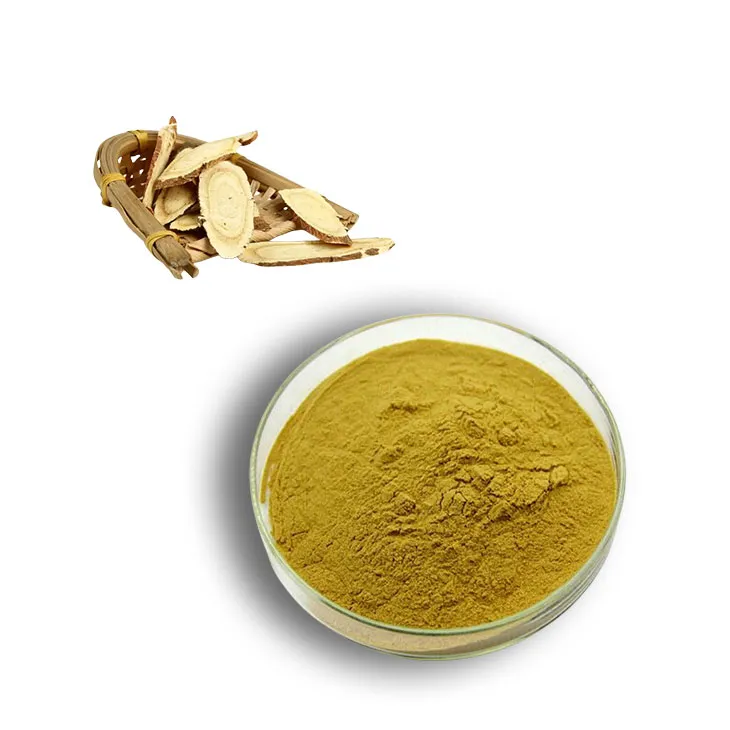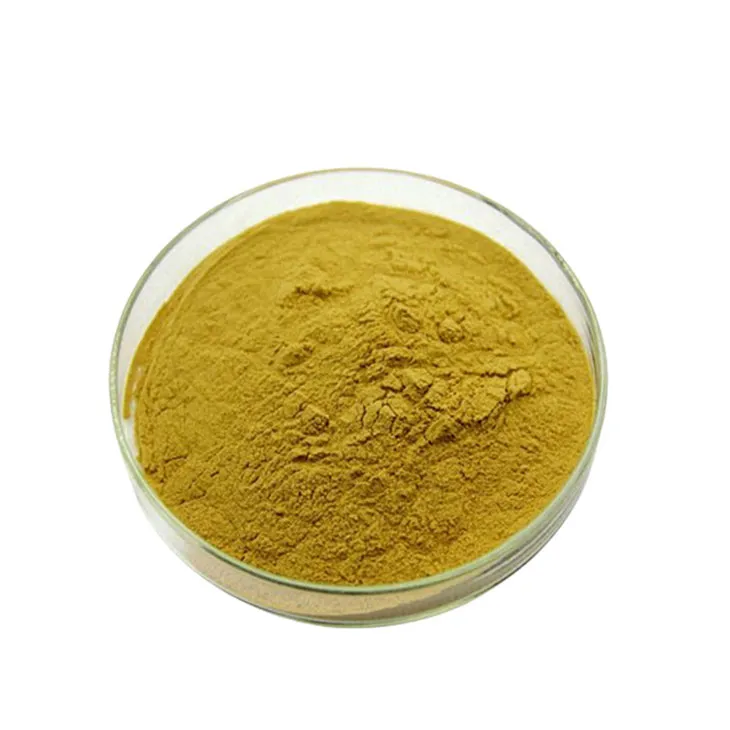- 0086-571-85302990
- sales@greenskybio.com
Supercritical Carbon Dioxide Extraction of Licorice Root Extract Powder.
2024-11-30

1. Introduction
Licorice root has been an important plant in traditional medicine across the globe for centuries. It is known for its various medicinal properties and has been used to treat a wide range of ailments. Supercritical carbon dioxide extraction of Licorice Root Extract Powder is a modern and efficient method that has gained significant attention in recent years. This process takes advantage of the unique properties of supercritical CO₂ to obtain high - quality extract powder from licorice root.

2. Licorice Root: A Medicinal Treasure
Licorice root, botanically known as Glycyrrhiza glabra, has a rich history of use in different cultures. In traditional Chinese medicine, it is considered a "harmonizing" herb, often used in formulas to balance the effects of other herbs. In Ayurvedic medicine from India, it is used for its digestive, respiratory, and anti - inflammatory properties.
The root contains numerous bioactive compounds. Glycyrrhizin, for example, is one of the most well - known components. It has been studied for its potential anti - inflammatory, antiviral, and hepatoprotective effects. Additionally, licorice root contains flavonoids, isoflavonoids, and other phenolic compounds that contribute to its antioxidant and anti - microbial properties.

3. Supercritical Carbon Dioxide: Properties and Advantages
Supercritical carbon dioxide is a state of carbon dioxide where it has properties that are intermediate between a gas and a liquid. This occurs when carbon dioxide is subjected to specific temperature and pressure conditions. At the supercritical state, CO₂ has a low viscosity like a gas, which allows it to penetrate easily into the matrix of the licorice root material. At the same time, it has a relatively high density like a liquid, enabling it to dissolve a wide range of compounds effectively.
One of the major advantages of using supercritical CO₂ for extraction is its selectivity. It can be tuned to preferentially extract certain compounds from the licorice root while leaving others behind. This is in contrast to some traditional extraction methods, such as solvent extraction, where a large number of unwanted compounds may also be extracted along with the desired ones.
Another advantage is the environmental friendliness of supercritical CO₂. Carbon dioxide is a non - toxic, non - flammable gas that is abundantly available. After the extraction process, it can be easily recovered and recycled, reducing waste and environmental impact.

4. The Supercritical Carbon Dioxide Extraction Process
4.1. Pretreatment of Licorice Root
Before the extraction process, the licorice root needs to be properly pretreated. This typically involves cleaning the root to remove dirt, debris, and other impurities. It may also be dried and ground into a suitable particle size. The particle size is an important factor as it affects the surface area available for extraction. A smaller particle size generally results in a higher extraction efficiency as it provides more contact area between the licorice root material and the supercritical CO₂.
4.2. Extraction Parameters
The extraction process is highly dependent on several parameters. Temperature and pressure are two of the most critical ones. The optimal temperature and pressure need to be determined based on the specific compounds to be extracted from the licorice root. For example, a certain temperature - pressure combination may be ideal for extracting glycyrrhizin, while a different combination may be better for extracting flavonoids.
The flow rate of supercritical CO₂ also plays a role in the extraction efficiency. A higher flow rate can increase the mass transfer between the CO₂ and the licorice root, but it may also lead to a shorter residence time of CO₂ in the extraction vessel, which could potentially reduce the extraction yield.
4.3. Separation and Collection of the Extract
After the extraction, the supercritical CO₂ containing the dissolved licorice root compounds needs to be separated from the extract. This is usually achieved by reducing the pressure of the CO₂ - extract mixture. As the pressure is reduced, the solubility of the compounds in CO₂ decreases, and the extract is deposited. The separated CO₂ can then be recycled back to the extraction process.
The collected extract is in the form of a powder, which can be further processed depending on its intended use. It may be purified to remove any remaining impurities, or it may be formulated into various products such as dietary supplements, cosmetics, or pharmaceuticals.

5. Quality and Purity of the Licorice Root Extract Powder
The supercritical carbon dioxide extraction method is known for producing a high - quality Licorice Root Extract Powder. Since the process is relatively gentle compared to some traditional extraction methods, the bioactive compounds in the licorice root are less likely to be degraded or altered. This results in an extract powder that retains a high level of its natural bioactivity.
The purity of the extract powder can also be well - controlled. By adjusting the extraction parameters, it is possible to obtain an extract that is rich in specific compounds while minimizing the presence of unwanted substances. For example, by carefully selecting the temperature and pressure, it is possible to produce an extract powder with a high glycyrrhizin content and low levels of impurities such as resins and waxes.
6. Applications of Licorice Root Extract Powder
6.1. In Traditional Medicine Modernized
In the field of traditional medicine modernized, licorice root extract powder has a wide range of applications. It can be used as an ingredient in herbal formulations to enhance the effectiveness of other herbs. For example, in some anti - inflammatory herbal mixtures, licorice root extract powder may be added to potentiate the anti - inflammatory effects of the overall formula.
It can also be formulated into single - ingredient dietary supplements for consumers who are interested in the potential health benefits of licorice root. These supplements may be marketed for their potential to support digestive health, liver function, or immune system function.
6.2. In Cosmetics
The antioxidant and anti - inflammatory properties of licorice root extract powder make it a valuable ingredient in cosmetics. It can be added to skin - care products such as creams, lotions, and serums. In these products, it may help to reduce skin inflammation, soothe irritated skin, and protect the skin from oxidative damage.
Licorice root extract powder may also be used in hair - care products. It has the potential to improve scalp health by reducing inflammation and may also contribute to hair strength and shine.
6.3. In Pharmaceuticals
Research on licorice root extract powder has shown its potential in the development of new pharmaceuticals. The bioactive compounds in the extract, such as glycyrrhizin, may be further studied and developed into drugs for treating various diseases. For example, glycyrrhizin has been investigated for its potential in treating hepatitis and certain viral infections.
Additionally, the anti - inflammatory properties of the extract powder may be useful in the development of drugs for inflammatory diseases such as arthritis.
7. Challenges and Future Perspectives
Although supercritical carbon dioxide extraction of licorice root extract powder has many advantages, there are also some challenges. One of the main challenges is the relatively high cost of the equipment required for the supercritical extraction process. The high - pressure vessels and associated control systems can be expensive to purchase and maintain.
Another challenge is the optimization of the extraction process for different varieties of licorice root. Different varieties may have different compositions of bioactive compounds, and therefore, the extraction parameters may need to be adjusted accordingly.
In the future, further research is needed to fully understand the potential of licorice root extract powder obtained by supercritical carbon dioxide extraction. This includes in - depth studies on the bioactivity of the extract, its safety in long - term use, and its potential interactions with other drugs or substances. There is also potential for improving the extraction process to make it more cost - effective and efficient.
FAQ:
What are the advantages of supercritical carbon dioxide extraction for licorice root extract powder?
The supercritical carbon dioxide extraction has several advantages. Firstly, it is precise, allowing for the targeted isolation of beneficial compounds from licorice root. Secondly, compared to traditional extraction methods, it is relatively gentle. This means that it can maintain the integrity of the bioactive substances in the licorice root, which is crucial for their effectiveness. Additionally, the obtained extract powder has high quality and is highly sought - after in various sectors.
What are the beneficial compounds in licorice root?
Licorice root contains a plethora of beneficial compounds. These include flavonoids, glycyrrhizic acid, and other bioactive substances. Flavonoids have antioxidant properties, and glycyrrhizic acid has been studied for its potential in treating various ailments, such as anti - inflammatory effects and possible antiviral activities.
How does supercritical CO₂ extraction work?
Supercritical CO₂ has properties between a gas and a liquid under specific conditions. In the supercritical state, it can penetrate the licorice root material effectively. It acts as a solvent, selectively dissolving the desired compounds. Then, by adjusting the pressure and temperature, the CO₂ can be easily removed, leaving behind the concentrated extract powder.
Why is the licorice root extract powder highly sought - after?
The licorice root extract powder is highly sought - after because of its potential applications. In traditional medicine modernized, it can be used for treating various ailments due to its bioactive compounds. It also has the potential to enhance the quality of consumer products, such as in the cosmetic and food industries, where its beneficial properties can add value.
Are there any limitations to supercritical carbon dioxide extraction of licorice root?
While supercritical carbon dioxide extraction has many advantages, there are also some limitations. The equipment required for this process can be expensive, which may limit its widespread use in some areas. Also, the optimization of extraction conditions, such as pressure, temperature, and extraction time, can be complex and requires careful study to ensure maximum yield and quality of the extract.
Related literature
- Supercritical Fluid Extraction of Bioactive Compounds from Medicinal Plants: A Review"
- "Licorice Root: A Natural Treasure with Multiple Health Benefits"
- "The Role of Supercritical CO₂ in the Extraction of Phytochemicals"
- ▶ Hesperidin
- ▶ citrus bioflavonoids
- ▶ plant extract
- ▶ lycopene
- ▶ Diosmin
- ▶ Grape seed extract
- ▶ Sea buckthorn Juice Powder
- ▶ Beetroot powder
- ▶ Hops Extract
- ▶ Artichoke Extract
- ▶ Reishi mushroom extract
- ▶ Astaxanthin
- ▶ Green Tea Extract
- ▶ Curcumin Extract
- ▶ Horse Chestnut Extract
- ▶ Other Problems
- ▶ Boswellia Serrata Extract
- ▶ Resveratrol Extract
- ▶ Marigold Extract
- ▶ Grape Leaf Extract
- ▶ blog3
- ▶ blog4
-
The best lemon juice powder in nature.
2024-11-30
-
Organic Vitamin K2 Powder Suppliers
2024-11-30
-
Bulk purchase of L - tyrosine.
2024-11-30
-
Vitamin K2 Manufacturers
2024-11-30
-
100% Pure Natural Rutin.
2024-11-30
-
Chinese Citrus Bioflavonoid Suppliers.
2024-11-30
-
Red Date Extract
2024-11-30
-
Troxerutin
2024-11-30
-
Black Pepper Extract
2024-11-30
-
Moringa powder
2024-11-30
-
Lemon Juice Powder
2024-11-30
-
Curcumin Extract
2024-11-30
-
Bayberry Extract
2024-11-30
-
Baicalin
2024-11-30
-
Tinospora cordifolia extract
2024-11-30
-
Cat Claw Extract
2024-11-30





















